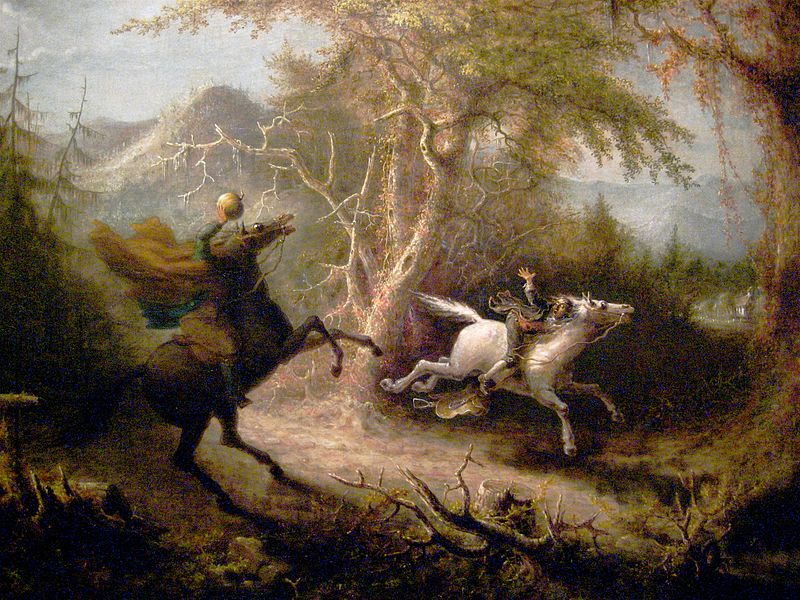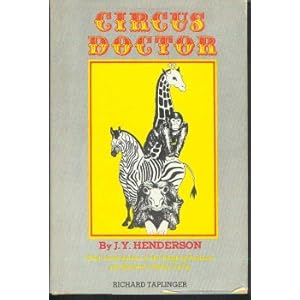Sunday, October 31, 2010
Happy Halloween!
"Haunted Hayride" in the anthology A Horse For All Seasons by Sheila Kelly Welch (1994)
With a jack o'lantern glowing out front and a surprising number of children trick-or-treating to the house (including one girl dressed as an equestrian! true story!), I am driven to a holiday posting. However, I do not have a suitable review and, inexplicably, horse books with a Halloween theme are thin on the ground, outside series books. In the short story quoted above, however, I hit a perfect connection to my last post; in Welch's tale, a teenage hayride goes awry when the organizer's little brother swipes her barrel-racing mare and stages a little Headless Horseman action.
Halloween
Mr. McFadden's Halloween by Rumer Godden (1975)
Phantom Rider: Ghost Horse by Janni Lee Simner
Phantom Rider: The Haunted Trail by Janni Lee Simner(1996)
Phantom Rider: Ghost Vision by Janni Lee Simner(1996)
The Saddle Club: Horse Magic (#47) by Bonnie Bryant (1995)
The Saddle Club: Ghost Rider (#24) by Bonnie Bryant (1992)
The Great Pumpkin Ride by Laura Hesse (2004)
Riding Academy: Mary Beth's Haunted Ride by Alison Hart (1994)
Pony Tails: Corey And The Spooky Pony by Bonnie Bryant (1996)
Animal Ark: Pony In A Pumpkin Patch (#49) by Ben M. Baglio (2006)
Ghost Stories with Horse
Mystery Horse by Margaret Goff Clark (1972)
Gypsy And The Moonstone Stallion by Sharon Wagner (1980)
The Mystery Of The Crimson Ghost by Phyllis A. Whitney (1969)
Sydney's Ghost by Carol Iden (1969)
The Ghost Pony by Lynn Hall (1978) (aka The Mystery Of Pony Hollow)
Ghost Horse by George Edward Stanley (2000)
Wednesday, October 27, 2010
The Headless Horseman

The Headless Horseman Pursuing Ichabod Crane, by John Quidor (1801-1881)
Oil, 26 7/8 x 33 7/8 in., Smithsonian American Art Museum.
Public domain via Wikimedia commons
The animal he bestrode was a broken down plow horse that had outlived almost everything but his viciousness He was gaunt and shagged with a ewe neck and a head like a hammer his rusty mane and tail were tangled and knotted with burrs one eye had lost its pupil and was glaring and spectral but the other had the gleam of a genuine devil in it Still he must have had fire and mettle in his day if we may judge from his name which was Gunpowder.
Links
Google Books - The Legend Of Sleepy Hollow
Thursday, October 14, 2010
Circus Doctor (1951) - nonfiction
I've never really liked circuses; the massive Ringling operation, the folksy modern-day tent shows, and the animal-less Cirque all leave me cold. That is, the shows leave me cold. The idea of being part of the circus, on the other hand, is fabulous. All that color and drama to take you away from drab and sordid reality. From Toby Tyler to The Greatest Show On Earth, I've always been a sucker for a circus story.
Plus, classic circus stories are like Westerns; even when they're bad, they have horses.

Circus Doctor
J.Y. Henderson, told to Richard Taplinger
1951, Little, Brown and Company
... the circus's biggest preoccupation was with its horses: Ringling Brothers had a fortune tied up in what was undoubtedly the most beautiful collection of horses in the world. They wanted everything possible done for the rest of their animals too, but experience had taught them that they couldn't expect that to be too much.
In September, 1941, John Ringling North called a young veterinarian and offered him a job. The vet, Henderson, was a partner in a mixed small/large animal practice in
In Ringling Brothers - Barnum & Bailey's winter quarters in Sarasota, Henderson is wary of his new, dangerous charges and takes comfort in the familiar:
On three sides of us there were open stalls, and on the fourth were box stalls where the most favored horses were kept. In the immediate center of the corral were patches of grass decorated with palm trees and a large watering trough... I examined the broad-beamed Percherons, smaller neat hackneys, smart American saddle horses, wild Arabians, the standard-bred horses, stockinged Clydesdales, and Andalusians.
Of course,
The busiest place in the world is not a beehive. It is not found by watching the ways of an ant, nor is it an army preparing for an invasion. The busiest place on earth is the grounds of a gigantic circus, two weeks before hitting the road for an eight-month season.
In that first year, with the value of vaccinations still in question,
While the pen boys stood there laughing, the two llamas chased me all over the pen. I was chastened and emerged unvictorious after being sprayed by both of them from head to foot.
Then there's the frankly alarming camel story, which I don't particularly care to relate in detail. Suffice it to say, camels appear to be extremely open-minded about personal matters most animals tend to regard with a great deal of jealousy.
I'd gladly walk a mile to keep from operating on a camel.
A year after he joins the circus,
I knew then there is something in animal make-up akin to greatness in men. It is not just their size or their swiftness; their fierceness or their power. There is an inner nobility and a kinship to what is enduring in nature.
This is a essentially a collection of moments connected by quick throwaway lines about non-circus life.
And finally, it is a testament to the power of horses to do truly odd, arguably idiotic things that in a book filled with escaping lions, runaway giraffes and very angry gorillas, many of the most memorable mishaps have to do with the horses. A saddle horse, waiting on the ramp into
Links
Billboard magazine article about the
Buckles Blog - covers circus history, features a photo of McClain's elephants
Buckles Blog - photo of
The Greatest Show On Earth (1952) - IMDB
Other equine info
Name-dropping
John Ringling North - owner of the circus
Dr. J.K. Northway - vet of the King Ranch
Damoo Dhotre - trainer
John Sabo - menagerie superintendent
Dick Clemens - cat trainer
Walter McClain - elephant trainer
Rudolph Mathies - tiger trainer
Justino Loyal - horse act
Saturday, October 9, 2010
A Very Young Rider (1977)

A Very Young Rider
Jill Krementz, author and photographer
1977, Borzoi Books, Alfred A. Knopf
This oversized photo essay chronicling the experiences of young rider Vivi Malloy is a classic much beloved by women who were horse-obsessed girls in the 1970s and 1980s. Beautiful, evocative black-and-white photos illustrate the everyday chores, training and life of 10-year-old Vivi and her chestnut pony Ready Penny. We also meet Vivi's family, trainer and various friends, and travel to horse shows where Vivi and her older sister Debby are competing. The action is narrated by Vivi, whose voice alternates between matter-of-fact steadiness about chores and riding, and gleeful excitement about special events like a trip to a big horse show.
Vivi is shown participating in Pony Club and doing chores common to all who own horses, but the core of the book is her participation in the world of elite hunter/jumper horse shows. Debby is in training with George Morris, former Olympic rider and de facto god of the hunter/jumper world, and Vivi's trainer is his assistant. Vivi and her sister show at
Plenty of women remember this book fondly; it's a very beautiful book and that alone made it attractive to a whole range of kids, from those who had Vivi-like aspirations of going to
If you were/are into showing, though, it was catnip. The horse show sequences are a who's who of that era's show world: Gordon Wright, Frank Chapot, George Morris, Michael Matz, Buddy Brown, Kathy Kusner, Bert de Nemethy, Rodney Jenkins.
It is dated now beyond the bell-bottoms and the harness-free velvet helmets:
I love cotton candy but it's so fattening. When I get older like Debby, I'll have to go on a diet. Debby's always on a diet or else George gets after her. Once she went on a pure liquid diet and almost fainted in school. I have to watch my weight now a little bit. You don't want to get too heavy for your pony. There's nothing uglier than a fat rider on a horse.
Granted, this is a book of its time and that time was blithely unaware of the dangers of encouraging teenage and adolescent girls to obsess over calories to the point of fainting. Still, that last little tidbit is telling. Morris is nearly as famous for his outspoken personality as for his riding and coaching, and he has long had a very strong opinion on weight. As times changed and possibly as he mellowed, he's toned it down, but the stories that circulate about his youthful comments are hair-raising. Worth seeking out, by comparison, is his monthly jumping critique at Practical Horseman magazine, as well as the happy parody of same at Hillbilly Farms.
Jill Krementz (1940-___)
A New Jersey native, she was married to Kurt Vonnegut.
Other Books
A Very Young Dancer
A Very Young Skater
A Very Young Circus Flyer
A Very Young Actress
A Very Young Gardener
A Very Young Gymnast
A Very Young Musician
A Very Young Skier
How It Feels To Be Adopted
How It Feels When A Parent Dies
How It Feels To Fight For Your Life
How It Feels When Parents Divorce
How It Feels To Live With A Physical Disability
A Visit To
Holly's Farm Animals
Jamie Goes On An Airplane
Lily Goes To The Playground
Zachary Goes To The Zoo
Sweet Pea: A Black Girl Growing Up In The Rural South
Black Writers
The Jewish Writer
The Writers Image
Writers Unbound
Links - the author
New York Social Diary - a bit about Krementz appears halfway down the page
Links - about the book
A May 1995 article about the book and its subjects at The Chronicle Of The Horse magazine. Extremely interesting, as it discovers what happened to everyone, ponies included; a pony nerd dream.
George Morris at Practical Horseman
Derby Hill, Buddy Brown's h/j training stable in
George Morris at The Showjumping Hall of Fame
Gordon Wright at The Showjumping Hall of Fame
Frank Chapot at The Showjumping Hall of Fame
Kathy Kusner at The Showjumping Hall of FameBert de Nemethy at The Showjumping Hall of Fame
Longview Farms, Dennis Murphy's h/j training barn in





